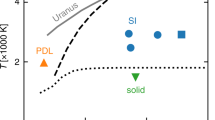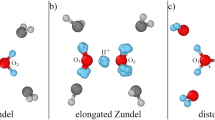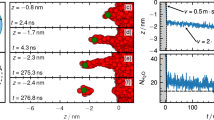Abstract
The anomalously fast motion of hydronium ions (H3O+) in water is often attributed to the Grotthuss mechanism1,2, whereby protons tunnel from one water molecule to the next. This tunnelling is relevant to proton motion through water in restricted geometries, such as in ‘proton wires’ in proteins3 and in stratospheric ice particles4. Transport of hydronium ions in ice is thought to be closely related to its transport in water1,2. But whereas claims have been made that such tunnelling can persist even at 0 K in ice5,6,7, counter-claims suggest that the activation energy for hydronium motion in ice is non-zero8,9,10. Here we use ‘soft-landing’11,12,13 of hydronium ions on the surface of ice to show that the ions do not seem to move at all at temperatures below 190 K. This implies not only that hydronium motion is an activated process, but also that it does not occur at anything like the rate expected from the Grotthuss mechanism. We also observe the motion of an important kind of defect in ice's hydrogen-bonded structure (the D defect). Extrapolation of our measurements to 0 K indicates that the defect is still mobile at this temperature, in an electric field of 1.6 × 108 V m−1.
This is a preview of subscription content, access via your institution
Access options
Subscribe to this journal
Receive 51 print issues and online access
$199.00 per year
only $3.90 per issue
Buy this article
- Purchase on Springer Link
- Instant access to full article PDF
Prices may be subject to local taxes which are calculated during checkout




Similar content being viewed by others
References
Hobbs, P. V. Ice Physics (Clarendon, Oxford, (1974).
Whalley, E., Jones, S. J. & Gold, L. W. (eds) Physics and Chemistry of Ice (Royal Soc. Canada, Ottawa, (1973).
Pomes, R. & Roux, B. Structure and dynamics of a proton wire: A theoretical study of H+ translocation along the single-file water chain in the gramicidin A channel. Biophys. J. 71, 19–39 (1996).
Bainco, R., Gertner, B. J. & Hynes, J. T. Proton transfer reactions at the surface of ice. Heterogeneous reactions involved in stratospheric ozone deletion. Ber. Bunsenges. Phys. Chem. 102, 518–526 (1998).
Eckener, U., Helmreich, D. & Engelhardt, H. in Physics and Chemistry of Ice (eds Whalley, E., Jones S. J. & Gold, L. W.) 242–245 (Royal Soc. Canada, Ottawa, (1973).
Petrenko, V. F. & Maeno, N. Ice field transistor. J. de Phys. C 48, 115–119 ( 1987).
Petrenko, V. F. Electrical Properties of Ice (Spec. Rep. 93-20, US Army Cold Regions Research and Engineering Laboratory, Hanover, NH, (1993).
Collier, W. B., Ritzhaupt, G. & Devlin, J. P. Spectroscopically evaluated rates and energies for proton transfer and Bjerrum defect migration in cubic ice. J. Phys. Chem. 88, 363–368 ( 1984).
Wooldridge, P. J. & Devlin, J. P. Proton trapping and defect energetics in ice from FT-IR monitoring of photoinduced isotopic exchange of isolated D2O. J. Chem. Phys. 88, 3086– 3091 (1988).
von Hipple, A., Runck, A. H. & Westphal, W. B. in Physics and Chemistry of Ice (eds Whalley, E., Jones, S. J. & Gold, L. W.) 236–241 (Royal Soc. Canada, Ottawa, (1973).
Tsekouras, A. A., Iedema, M. J., Ellison, G. B. & Cowin, J. P. Soft-landed ions: a route to ionic solution studies. Int. J. Mass Spectrom. Ion Proc. 174, 219–230 (1998).
Kleyn, A. W. Ion-surface interactions — from channelling to soft-landing. Science 275, 1440–1441 ( 1997).
Miller, S. A., Luo, H., Pachuta, S. J. & Cooks, R. G. Soft-landing of polyatomic ions at fluorinated self-assembled monolayer surfaces. Science 275, 1447–1450 (1997).
Engelhardt, H. in Physics and Chemistry of Ice (eds Whalley, E., Jones, S. J. & Gold, L. W.) 226–235 (Royal Soc. Canada, Ottawa, (1973).
Pfeifer, R. & Hertz, H. G. Activation energies of the proton-exchange reactions in water measured with the 1H-NMR spin echo technique. Ber. Bunsenges. Phys. Chem. 94, 1349– 1355 (1990).
Strongin, D. R., Mowlem, J. K., Lynne, K. G. & Kong, Y. Efficient magnetic focusing of low-energy ions (1–5 eV) onto solids for use in surface chemistry studies. Rev. Sci. Instrum. 63, 175–188 (1992).
Tsekouras, A. A., Iedema, M. J. & Cowin, J. P. Soft-landed ion diffusion studies on vapor-deposited hexane films. J. Phys. Chem. (submitted).
The KP5000 system (McAllister Technical Services, Coerd'Alen, Idaho 83815, US ).
Materer, N. et al. Molecular surface structure of ice (0001): dynamical low-energy electron diffraction, total-energy calculations and molecular dynamics simulation. Surf. Sci. 381, 190–210 (1997).
Tuckerman, M., Laasonen, K., Sprik, M. & Parrinello, M. Ab initio molecular dynamics simulation of the solvation and transport of hydronium and hydroxyl ions in water. J. Chem. Phys. 103, 150– 161 (1995).
Kunst, M. & Warman, J. M. Nanosecond time-resolved conductivity studies of pulse ionized ice. 2. The mobility and trapping of protons. J. Phys. Chem. 87, 4093–4095 (1983).
Johari, G. P. & Jones, S. J. Study of the low-temperature “transition” in ice 1 h by thermally stimulated depolarization measurements. J. Chem. Phys. 62, 4213–4223 (1975).
Hermansson, K. & Ojamäe, L. On the role of electric fields for proton transfer in water. Solid State Ionics 77 , 34–42 (1995).
Acknowledgements
We thank S. E. Barlow for advice. This work was conducted in the Environmental Molecular Sciences Laboratory, a collaborative users' facility of the US Department of Energy (DOE), under the Office of Biological and Environmental Research, and was supported by the Division of Chemical Sciences, US DOE. Pacific Northwest National Laboratory is operated by Battelle Memorial Institute for the US DOE.
Author information
Authors and Affiliations
Corresponding author
Supplementary information
Rights and permissions
About this article
Cite this article
Cowin, J., Tsekouras, A., Iedema, M. et al. Immobility of protons in ice from 30 to 190 K. Nature 398, 405–407 (1999). https://doi.org/10.1038/18848
Received:
Accepted:
Issue Date:
DOI: https://doi.org/10.1038/18848
This article is cited by
-
Spin-ice physics in cadmium cyanide
Nature Communications (2021)
-
Internal motions of a quasiparticle governing its ultrafast nonlinear response
Nature (2007)
Comments
By submitting a comment you agree to abide by our Terms and Community Guidelines. If you find something abusive or that does not comply with our terms or guidelines please flag it as inappropriate.



